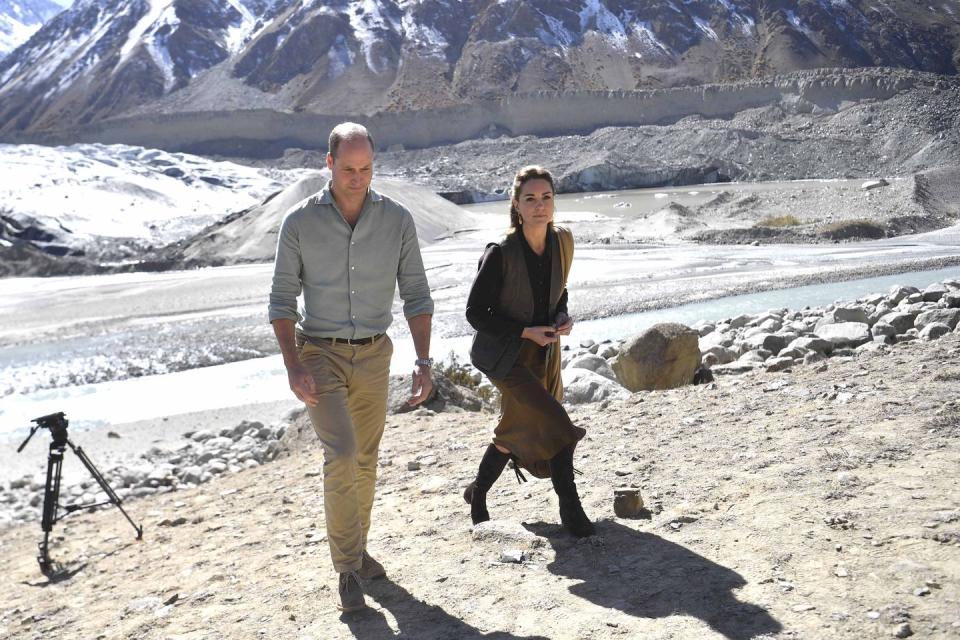Prince William Discusses How His Children Motivate His Environmental Work

It’s not often that a member of the British royal family invites cameras to follow their every move, but when Prince William was approached by British documentary makers to shadow his environmental work for two years, there was only one answer for the future king.
“Someone has to put their head above the parapet and say, I care about this,” the Duke of Cambridge says of his decision to take part in the ambitious TV documentary, titled Prince William: A Planet For Us All, which will show the royal champion major action for the natural world. “To have the belief that if we all work together, we can make a difference.”
His hopes, he says in the footage, is to inspire young people and local communities around the world to create a more positive relationship with the environment. “I owe it to them to help their voices be heard,” he says in the 90-minute special, which will air in the U.K. on October 5. “That generational gap has to be bridged somehow so that the older political leaders understand that the younger generation means business. They want their futures protected. I feel it is my duty and our collective responsibility to leave our planet in a stronger position for our children.”
In a preview of the ITV documentary shared by Kensington Palace with BAZAAR.com, Prince William is seen on travels that take him from Africa to Asia and many parts of the U.K., including London, Liverpool, and Sandringham. It’s on the estate of the latter that William reveals he grew up feeling a “deep connection” with the outdoors inherited from his father Prince Charles and grandfather Prince Philip. “My grandfather, my father, have been in the conservation, the environmental work for many years,” he says. “My grandfather was well ahead of his time. My father was ahead of his time. And I really want to make sure that, in twenty years, George doesn’t turn around and say, are you ahead of your time? Because if he does, we’re too late.”
Throughout the show, William makes it clear that his children and future generations are the driving force behind his dedication to protecting the planet and helping repair the natural world. "Now I have got George, Charlotte, and now Louis in my life—your outlook does change," he says. "You want to hand over to the next generation, the wildlife in a much better condition."
William’s first taste of conversation, he shares, was a child himself, visiting remote parts of Africa. In the show, he returns to a rhino sanctuary in Tanzania. Feeding a carrot to a rhino called Deborah, the duke opens up on camera about his fears for the mammals. “People might see them and think it’s a big tank, a big hulk of an animal, with a big horn, but they are incredibly vulnerable,” he says. “They have brilliant eyesight and people will take advantage of that and they want this horn, which is effectively a nail, and that is all it is, its fingernail. This is where the horn belongs, on a live rhino and that’s where it should stay.”
The issue is close to his heart, having advocated for the work of conservation charity Tusk Trust since 2005 and repeatedly called for the end of illegal wildlife trade. Looking at the collection of 43,000 tusks (valued at over $64 million) which have been impounded at a secure unit in the East African country, he struggles to hold back his tears. “It’s a mind blowing number of tusks, it really is. You can’t get your head around it,” he says.
Other moments in the special show William with wife Duchess Kate picking litter on a beach in Anglesey, Wales, where they first lived as a married couple. The couple can also be seen meeting the world’s most beloved naturalist, Sir David Attenborough at a ship-naming ceremony. “The children were very upset that we were coming to see you and they weren’t coming,” the Duchess of Cambridge laughed when meeting the 94-year-old. “They are massive fans of yours!”
The Cambridges also allowed documentary cameras to join them on their fall 2019 tour of Pakistan. In a scene where the couple are shown glaciers melting at record speed due to global warming, Kate comments, “Everyone’s asking all of us to protect the environment and what comes first is actually just to care about it in the first place. And you’re not necessarily going to care about it if you don’t know about it and that’s why we thought it was so important to come here.”

William’s conservations efforts are also seen near their Anmer Hall countryside home on the Sandringham estate, where he has been helping boost the numbers of insects in the area by planting trees amongst the barley and wheat fields (research shows that the insets will help protect the crops from pests, meaning less damaging pesticides are needed).
In one of the final scenes, William is seen kayaking at a Hackney, London marshland that has been transformed into a vibrant nature reserve. As he glides through the water, the Duke of Cambridge reflects on the coronavirus pandemic and its effect on the world. “I can’t talk about coronavirus without mentioning about how many people sadly lost their lives and how terrible and sad that all is,” he says. “But I think the tiny little ray of light, if, if there’s any ray of light from this, is that it allows us to take stock and to refocus our priorities.”
He adds, “I’ve been really heartened by what I’ve been hearing from other people and how they’ve started to appreciate nature and experience it ... If we can provide the same motivation with the environment we will have truly turned a corner. Investment, green fashion. We need to build back greener. Young people won’t stand for saying it’s not possible.”
You Might Also Like

